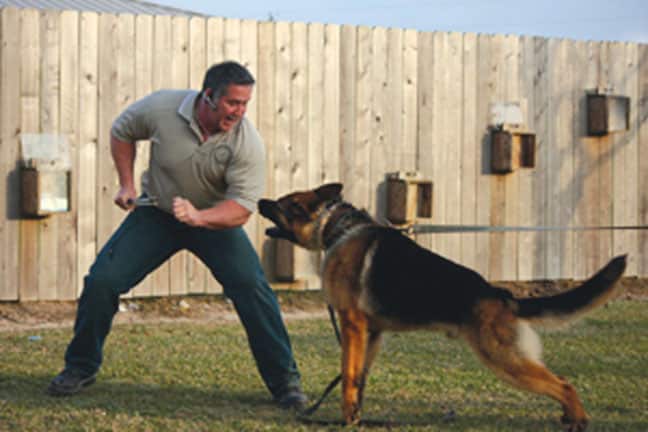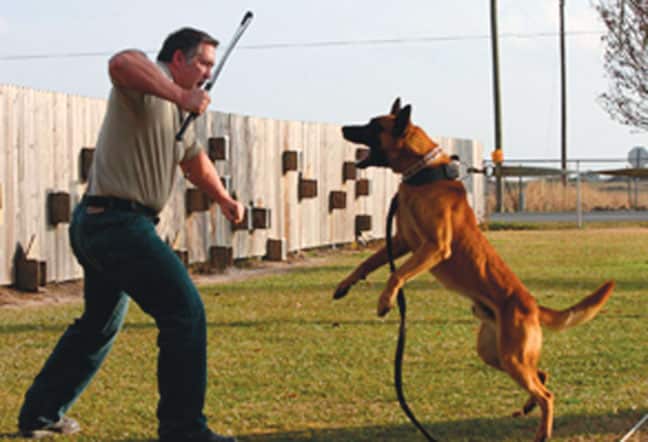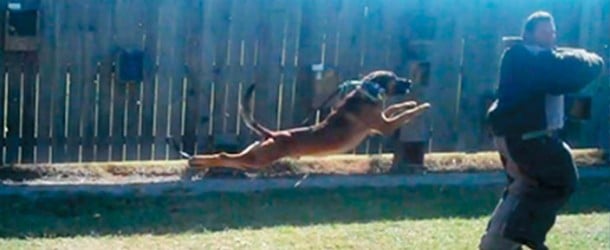By Karla Wall
For Roger Abshire, owner of USK9 Academy in Kaplan, La., and recognized as one of the top protection, police and detection dog trainers in the world, the work of training such highly-skilled dogs can be boiled down to a simple credo.

It’s an innate skill most people don’t have — most people tend to communicate with dogs on a human level. But Abshire discovered as a young boy that he possessed that special ability to understand and communicate with dogs.
“As a young boy, I found that I had the ability to do things with a dog that most people couldn’t,” he says.
He first noticed this ability when playing with a neighborhood German shepherd named Joe. Abshire soon had Joe doing basic obedience exercises, later adding some fun tricks to the mix. He had found his calling.
“I went to neighbors and asked to train their dogs,” Abshire says. “Through word of mouth, the list of dogs grew, and my hobby became a paying job.”
And the paying job became quite a distinguished career. Abshire landed a job at Sentry Place, a training center in Dallas, where he worked with narcotics, protection and explosives dogs. From there, he went to Europe, where he worked for some of the top dog trainers in the world.
Abshire’s now counted among those top trainers. His CV is extensive; he’s turned out top protection and detection dogs. He’s worked with the U.S. Army to train specialized detection dogs. He’s worked with defense contractors to develop training techniques for explosives, biological weapons and chemical weapons detection dogs. The techniques that Abshire’s developed, in fact, are now considered a trade secret by the government.

Abshire’s published extensively — articles in national magazines on topics ranging from training service dogs to solving problem behaviors such as begging, submissive urination, barking, and refusal to come when called. He’s also appeared on radio and television programs, offering advice for dog owners and trainers.
At USK9 Academy, Abshire works with dogs on many levels: He does basic and advanced obedience on an appointment basis with owners and handlers, and also on a drop-off basis, where owners drop their dogs off at the school, and come back in several days to pick the dog up and learn how to work with the dog themselves. He holds classes and certification programs for law enforcement canine handlers, trains law enforcement dogs to be purchased by law enforcement agencies, and even trains service dogs for the handicapped, as well as personal protection dogs.
But Abshire also spends a huge amount of time traveling, doing follow-up training and tune-up for high-profile clients, and also choosing young dogs to train as future protection and detection dogs.
Most of those “puppy-seeking” trips, he says, are to Europe, where he tests and evaluates an enormous number of dogs.
“I’ll probably look at over 500 dogs on one trip overseas,” Abshire says. “And, out of those dogs, I’ll probably take home 10.”
What does he look for in a future canine superstar?

While breeds such as German shepherds, Belgian malinois and tervuren, Doberman pinschers and Rottweilers come to mind as protection and detection dogs, Abshire says he’s worked with a wide range of breeds, including German shorthair pointers, Jack Russell terriers, Labrador retrievers, Alaskan malamutes and cocker spaniels.
The most difficult part of Abshire’s job? Training the human part of a team.
“Some people just have no connection to dogs; some can only relate to a dog in human terms,” he says. “I’ve had many failures in training law enforcement officers to handle dogs.”
That ability to relate to and work with dogs, Abshire says, is more necessary now than ever before.
“Dogs are no longer simply for working,” he says. “Today’s dogs are more likely to be family members. So when a problem arises, it’s at the forefront — it affects the family. More people now than ever before are interacting with dogs, so problems are more likely to crop up.”
What, then, is Abshire’s advice to people who want to try to train their dog, and work with their dog on improving its behavior?
“You have to understand your dog,” he says. “You have to know how to relate to it on its level. You have to be patient. You have to be able to control your voice and body language — you want an excited voice when you praise your dog, a calm voice when you want it to stay calm.”
The basic philosophy he passes on to the dog owners he trains, Abshire says, is simple.
“When you try to communicate with your dog in human terms, your dog will treat you like a dog.”
















Comments are closed.